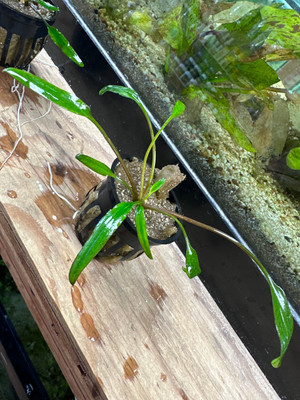Cryptocoryne Lutea: Exploring the Beauty and Versatility of the Yellow Crypt
Posted by Max Gandara on on 18th Apr 2024
Cryptocoryne Lutea: Exploring the Beauty and Versatility of the Yellow Crypt
Cryptocoryne Lutea, also known as the Yellow Crypt, is a popular aquatic plant prized for its vibrant yellow-green foliage, ease of care, and versatility in aquascaping. Belonging to the Araceae family, this species originates from regions of Southeast Asia, where it thrives in the submerged environments of rivers, streams, and marshy areas. In this comprehensive guide, we delve into the various aspects of Cryptocoryne Lutea, from its taxonomy and natural habitat to its cultivation, propagation, and creative applications in aquascaping.
Taxonomy and Morphology: Cryptocoryne Lutea is a member of the Cryptocoryne genus, which comprises over 50 recognized species of aquatic plants. Characterized by its rosette-forming growth habit, C. Lutea typically develops lanceolate or elliptical leaves with a distinctive yellow-green hue. The leaves may exhibit slight variations in color and texture depending on environmental conditions, ranging from light green to golden-yellow, with a glossy or matte surface texture.
Natural Habitat: Native to regions of Southeast Asia, including India, Sri Lanka, and Indonesia, Cryptocoryne Lutea is commonly found in shallow waters with nutrient-rich substrates. In its natural habitat, this species thrives in environments with moderate water flow and subdued lighting, often growing alongside other aquatic vegetation. Its adaptation to varying water conditions, including soft to moderately hard water and acidic to neutral pH levels, contributes to its widespread distribution in aquatic habitats.
Cultivation Requirements: Cultivating Cryptocoryne Lutea in aquariums requires attention to specific environmental parameters to promote healthy growth and vibrant foliage. Adequate lighting, preferably provided by LED fixtures with adjustable intensity, is essential for maintaining optimal photosynthetic activity and leaf coloration. Additionally, stable water parameters, including temperature (22°C to 28°C or 72°F to 82°F), pH (6.0 to 7.5), and hardness, help ensure the well-being of this species.
Substrate: Cryptocoryne Lutea benefits from a nutrient-rich substrate, such as aquasoils or nutrient-enriched gravel, which provides essential minerals and supports root development. A fine-grained substrate with good water retention properties aids in nutrient uptake and prevents root disturbance. Root tabs or liquid fertilizers can be used to supplement substrate nutrients and promote vigorous growth.
Propagation: Propagation of Cryptocoryne Lutea can be achieved through division of rhizomes or by cultivating daughter plants produced along the rhizome. Carefully separate the rhizome into sections containing healthy shoots and root systems, then replant the divisions into the substrate. Alternatively, daughter plants can be gently detached from the mother plant and replanted in suitable areas to establish new growth.
Maintenance and Care: Regular maintenance is essential for sustaining the health and vibrancy of Cryptocoryne Lutea in aquariums. Pruning dead or decaying leaves and removing algae growth helps maintain a tidy appearance and prevents nutrient competition. Routine water changes, substrate vacuuming, and monitoring water parameters are integral parts of plant care to prevent nutrient imbalances and algae outbreaks.
Aquascaping Applications: Cryptocoryne Lutea's vibrant yellow-green foliage and compact growth habit make it an excellent choice for various aquascaping layouts. Whether used as a foreground accent or a midground filler, this versatile species adds visual interest and contrast to aquatic landscapes. Its ability to thrive in low to moderate light conditions makes it suitable for both beginner and experienced aquarists seeking to create lush underwater environments. When combined with other aquatic plants, such as mosses, ferns, and stem species, Cryptocoryne Lutea contributes to dynamic and visually appealing aquascapes, enhancing their overall aesthetic appeal.
Cryptocoryne Lutea stands as a testament to nature's beauty and adaptability, captivating aquarists with its vibrant foliage and ease of cultivation. By understanding its requirements and implementing proper care practices, hobbyists can enjoy the splendor of Cryptocoryne Lutea in their aquariums, creating immersive and captivating underwater landscapes for all to admire.

